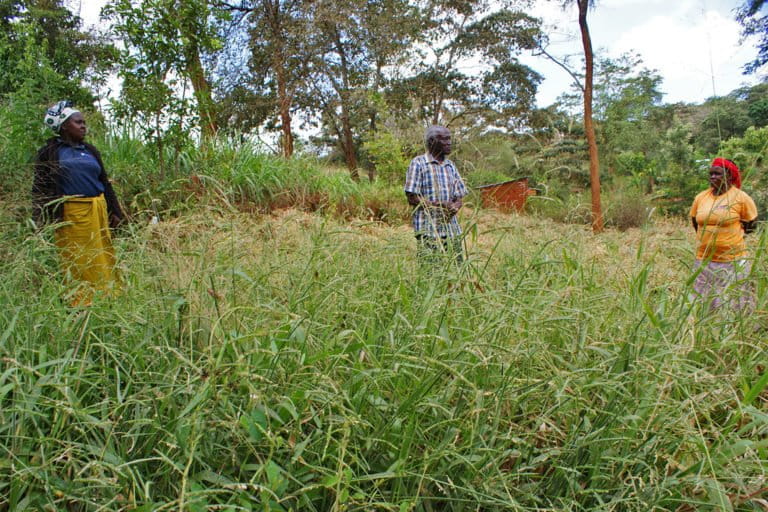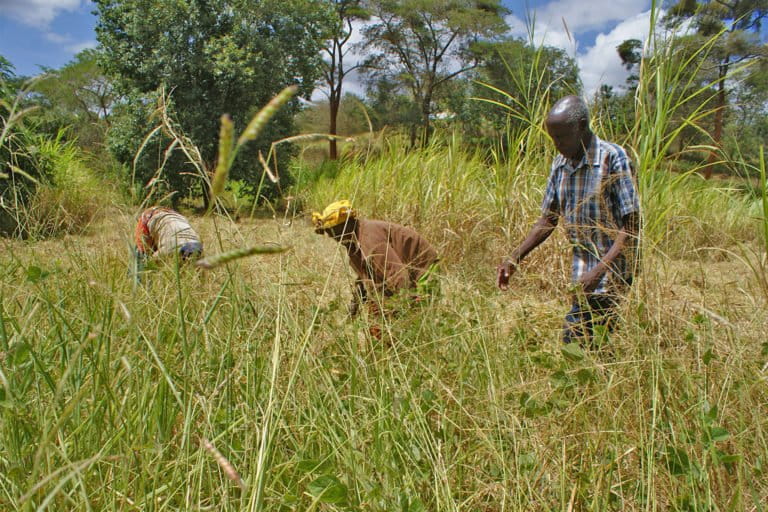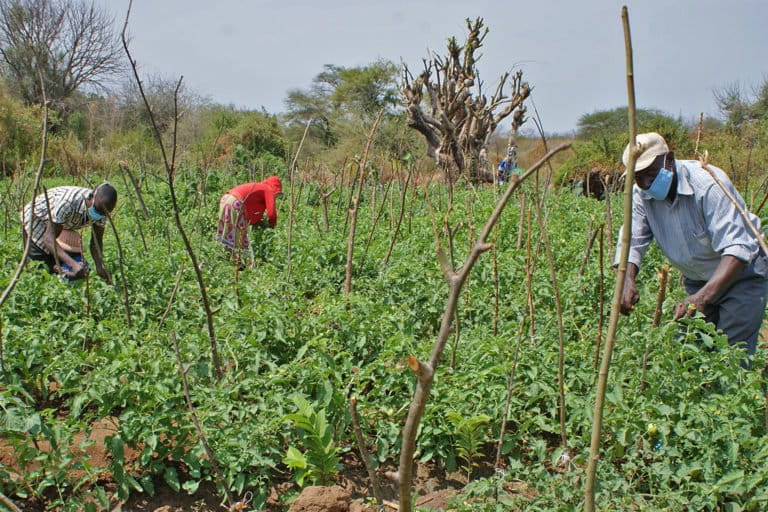- Farmers in Kenya are experimenting with the “push-pull” method to deal with insect pests without having to use costly and polluting pesticides.
- The technology involves intercropping food plants with insect-repelling legumes to push the bugs away, and ringing the plots with plants that attract, or pull, them even farther out.
- Working with 642 farmers from 56 villages in eight counties, researchers found that farmers who applied the push-pull method nearly doubled their yields over those of their neighbors.
- While adoption of push-pull farming remains low, in part because of higher labor costs, proponents say it offers a win-win for farmers through higher yields and avoidance of chemical pesticides.
NAIROBI — Munene Njoka, a young farmer from central Kenya, is furious. The reason for his rage is a bundle of decaying maize stacked in a corner of his home.
The maize was attacked by stem borers, a pest that swarms cornfields. The stem borer invasion forced Njoka to remove the affected crop from his farm to prevent the pest from spreading to the rest of his crop.
It didn’t work.
“The pest seemed unstoppable,” says the 32-year-old. “To save my maize crop I sprayed it with chemicals bought from local agro-dealers. The purchases depleted my savings.”
The pesticides did the trick and Njoka eventually contained the spread. He was not aware, however, that by solving one problem, he may have exacerbated another.
According to studies, agrochemicals are some of the leading polluters of water bodies in rural Kenya, because they leach into rivers and lakes.
Moreover, produce that has been sprayed with chemicals may still be laced with residues of the substance when they are eaten.
One way Njoka might battle future pest attacks without incurring costs and polluting the environment is by adopting something called “push-pull technology,” according to Claire Nasike, from Greenpeace Africa’s Food for Life campaign.

Nasike says the technology is an innovation that involves intercropping cereal crops with insect-repelling legumes of the Desmodium genus, and then planting attractive forage plants such as napier grass as a border to the crop.
The intercrop emits a blend of compounds that repel, or “push” away, the pests, while the border plants emit semiochemicals that are attractive to the pests, or “pull” them toward the border, Nasike says.
“The push and pull technology does not harm soil and water sources, which are critical agricultural components,” she says. “It is an ecological farming method that combines modern science and innovation with respect for nature and biodiversity.”
Njoka’s battle was with stem borers, but elsewhere in Kenya, farmers for years have been struggling with crop losses due to a combination of the stem borer and Striga, a genus of parasitic plants commonly known as witchweed.

According to a 2018 paper in Land Use Policy, the stem borer pest can cause crop losses of up to 88%, while Striga can destroy an entire crop, even as farmers struggle with soil degradation.
But the study in western Kenya also found that employing the push-pull technique can save farmers from many of these losses, because it enhances soil fertility by taking in nitrogen and adding organic matter. This can lead to massive increases in yields.
Working with 642 farmers from 56 villages in eight of the 11 counties, researchers found that farmers who applied the push-pull method nearly doubled the yields over their neighbors who did not.
While intercropping prevents the spread of striga and other weeds, there are even more benefits: forage harvested from the napier grass can increase milk production if the grass is fed to livestock. Those using the technology also increased their overall income (both in crop and milk income) by 55 percent compared with those that did not, while annual milk yield was about 460 liters per cow.
This can help farmers raise additional income while increased milk consumption at home may help meet their families’ nutritional needs, according to the report.


“It becomes a self-reliant system over time if one knows what they are doing,” says Josphat Macharia, a farmer from south western Kenya. “I have been practicing organic agriculture for years and I have learnt that everything that you grow in the farm can be inter-dependent. You just have to know the right ones.”
Macharia’s farm has been used as a case study by researchers because of his long knowledge and application of organic farming. Here, a visitor will notice that fields of maize are intercropped with pulses.
Fleshy dairy cattle munch all day on the napier grass that has been harvested on the edges of every plot of crop on Macharia’s farm. Even the field of fresh produce is ringed with towering napier grass.
Macharia says push-pull technology is just one of the innovations he is employing on his organic farm. Others include making worm juice to enrich his crop instead of applying fertilizer. Here, Macharia rears earthworms to generate high-nutrient fluid. He adds their fluid directly to the soil to increase fertility. Earthworms naturally use their body system to break down soil and food particles, turning them into rich soil.
Macharia also rears various species of birds, including owls, so that they can prey on pests such as mice, caterpillars and other crop bugs, instead of applying pesticides.
“The benefits are many with organic farming, including being assured that my borehole water is safe from chemical leakage,” he says. “The push and pull technology is especially reliable because you just leave your crop to manage itself and move on to do other things.”

It’s not all easier, however. Push-pull often requires extra labor. The study found that the cost of labor was higher by 48% for those using push-pull technology. Still, for many farmers the math will work out, given potentially much higher yields.
Samuel Ledermann, a co-author of the 2018 paper and an assistant professor at George Washington University’s Elliott School of International Affairs, says the findings in western Kenya could be replicated elsewhere in the country.
However, researchers say that the adoption of push-pull is currently limited and, given this, much more needs to be learned about its economic and environmental benefits, including soil health, despite its promising potential.
“I have never heard of push-pull technology. But if it is something that can help me increase my yields I would be very happy to adopt it,” says Jane Muthoni, a fresh-produce farmer from the Mount Kenya region.
Muthoni says she prefers conventional agriculture, employing agrochemicals to manage her crops. According to her, conventional farming comes with higher returns compared to other agricultural systems.
A 2016 report by the Switzerland-based Research Institute of Organic Agriculture (FiBL) notes that deciding which agricultural production system is best — in terms of productivity, environmental health, and societal acceptance — is an ongoing debate. And climate change may alter the terms of that debate altogether.
The analysis found that organic agriculture “is generally perceived as not being able to support and sustain high productivity to meet the local and global food demand.” But results at two trial sites where FiBL conducted research in central Kenya proved that yields through organic and conventional agriculture — using both chemicals and fertilizers — were almost equal.


Many experts have long criticized conventional agriculture for its potential to cause long-term impacts to soil health, sustainability of yields, and the wider ecosystem. Moreover, research has shown that conventional agriculture releases more greenhouse gases than organic.
Meanwhile, push-pull technology is fanning out among the lowlands of Kenya where farmers have been experiencing swarms of the invasive fall armyworm (Spodoptera frugiperda) and prolonged drought, potentially linked to our warming climate.
Dominic Omondi, an agricultural officer in Makueni county, southern Kenya, says farmers here use brachiaria grass instead of napier grass to fence off their farmed plots. This grass also repels pests and can be used as food for livestock.
“More and more farmers are adopting this technology. The only problem is that the desmodium legume dries up quickly due to the high temperatures experienced here,” Omondi says.
Further uses of the push-pull concept will require tinkering given different regions and rising temperatures in Kenya and around the world. But for many farmers, push-pull could be a win-win.
Citation:
Kassie, M., Stage, J., Diiro, G., Muriithi, B., Muricho, G., Ledermann, S. T., … Khan, Z. (2018). Push-pull farming system in Kenya: Implications for economic and social welfare. Land Use Policy, 77, 186-198. doi:10.1016/j.landusepol.2018.05.041
